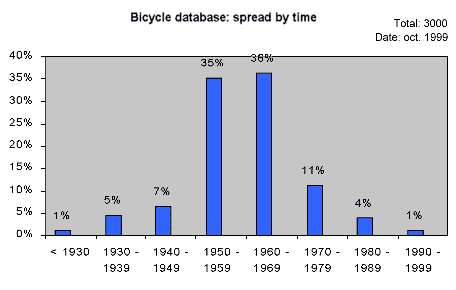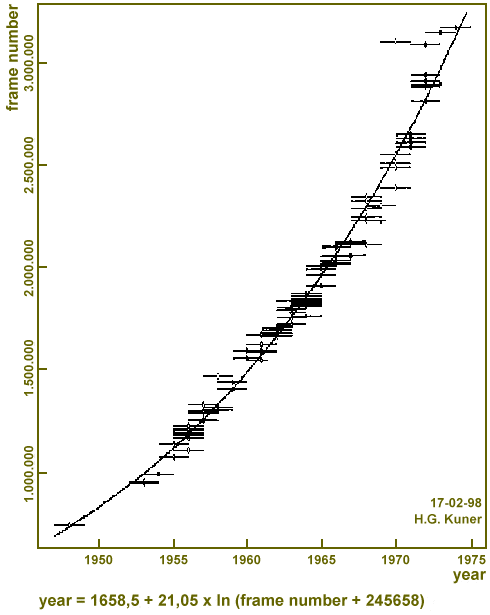 |

|
 |
|
 |
| The bicycle database |
| Since
1995 I collect data on old bicycles. By October 1999, the resulting database contained
data of more than 3,000 bicycles. 87% of these are Dutch, 7% are German, 4% are British
and 2% are of a different origin. The spread of the data by year of construction is shown
in the next figure.

Registered bicycles
spread by year
The values for the period up to 1959
mirrors -in my opinion- a valid picture of the actual today's 'on the street' situation.

As the figure shows, the emphasis lies on Dutch bicycles of
the fifties and sixties. Of this category, approximately 1 of 5,000 bicycles ever produced
is registered in the bicycle database.
|
| Identifying year and brand |
|
Initially,
the database can be used to determine the year of construction by means of comparison.
Apart from making lists of bicycles that are still provided with an original rear hub with
a stamping of the year of manufacture, the year can be estimated by comparing certain
parts. An example: "Koets A"-type rear lights were almost exclusively fitted to
Gazelle, Juncker, Fongers, and Locomotief bicycles older than 1955.

For Gazelle, there is a list of frame numbers and the
corresponding year of manufacture which ends in 1950. The chart on this page includes 100
Gazelle bicycles of the period after 1950. The formula can be used to derive the year
corresponding to a frame number. The resulting year is usually correct within a margin of
one year.

The values shown in the chart represent the year of
construction of the hub. The frame will be assembled some months later. In the formula
this is taken into account. A resulting year, e.g. 1966.0, should be interpreted as
'middle 1966', thus not as January 1966, but as June 1966.

Dating Gazelle bicycles
between 1950 - 1973
If a headset label is missing and no brand
name can be found, specific characteristics may be the way out. What kind of frame number,
where is it stamped-in, type of bottom bracket, type of headset-lugs etc. Sorting and
selecting these data with the aid of a powerful database application, it can be possible
to deduct the brand.
|
|
|
General information about the bicycle industry
|
|
|
The database offers information about
the approximate production rate of specific brands, and sometimes about which factory
produced what kind of bicycles.

During the merger of Locomotief and Simplex (between 1952
and 1965), these brands sold 40% gents’ models and 60% ladies’ models. With the
Gazelle company this ratio was the same. While L & S produced 25% roadsters
(rim size 28 x 1 1/2 inch), with Gazelle this type of bicycles covered
almost 40%. Moreover, L & S sold strikingly many ‘budget-bikes’
equipped with freewheel and caliper brakes. Of course, these figures assume that the
bicycles still 'on the road' today give a correct image of what was sold then.

But there is more general information to be derived from
this database: aluminium rims for sports and roadster bicycles were introduced in 1948.
(Racers already used these in the thirties.) From 1949 onwards, these rims -mostly
produced by Lepper- can be found on many Dutch bicycles of almost every brand. After 1964,
this hype was more or less over.

Another example: the 45 mm Thompson bottom bracket, which
was a typical Dutch feature. This type of bottom bracket vanished around 1960. Phoenix and
Germaan stopped production at about that time, Juncker did so already ten years before,
whereas Gazelle, Union (43 mm) and Veeno used these brackets for another couple of years.
Ten years later, the same happened to the roadsters' seat stays made from ovalized tubes.

Another interesting subject is the frame geometry of these
bicycles. The head-tube of the loop-frame type ladies' bicycles was mostly 270 to 280 mm
long, making them the 'real granny's bicycles' with very comfortable steering properties.
Fongers used head-tubes of a meagre 243 mm long (al least up from the twenties of the past
century). Juncker and Union 'shortened' the measure of theirs in about 1950, Phoenix did
so some years earlier, while Gazelle followed suit in two steps in 1956 and 1959. Some
other brands made bicycles with a head-tube of even 300 mm long!
|
|
|
Hard-to-determine brands |
|
|
Rare brands might be troublesome to
date reliably with the aid of the bicycle database, because of the small number of
bicycles still 'alive'. However, for the purpose of brand identification data of these
bicycles can be very useful. But even the well-known brands can be problematic, especially
when the system of frame numbering is complicated.

Juncker, Locomotief and Simplex, who finally merged, give a
good example. Until the late sixties, all of them used more than one numbering sequence,
additionally using a coded system. By collecting as much frame numbers of these brands as
possible and comparing the bicycles' characteristics, even that could be deciphered.
|
|
Translation by Dirk den
Hamer. Thank you, Dirk!
Copyright by
Herbert Kuner, (c) 2000
All rights reserved.

Last update: 02/24/2000
|